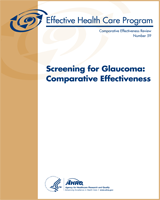NCBI Bookshelf. A service of the National Library of Medicine, National Institutes of Health.
Ervin AM, Boland MV, Myrowitz EH, et al. Screening for Glaucoma: Comparative Effectiveness [Internet]. Rockville (MD): Agency for Healthcare Research and Quality (US); 2012 Apr. (Comparative Effectiveness Reviews, No. 59.)
This publication is provided for historical reference only and the information may be out of date.
The Agency for Healthcare Research and Quality (AHRQ) Effective Health Care Program requested a Comparative Effectiveness Review of screening for open-angle glaucoma. The topic was selected through the Effective Health Care Program nomination process and refined with input from clinicians, consumers, professional organizations and other stakeholders with experience relevant to glaucoma screening and treatment.
Background
Glaucoma is a leading cause of visual impairment and blindness and affects approximately 60.5 million people worldwide.1,2 Although glaucoma may be characterized by optic nerve damage, visual field loss and elevated intraocular pressure, there is no consensus definition for confirming diagnosis.3 Damage is irreversible, so early detection can prevent severe vision loss. Open-angle glaucoma (OAG), the most common subtype of the disease, affects more than 2.5 million people in the United States, with a median age-adjusted prevalence of 4.6 percent, and 1.6 percent, among black and white people, respectively (based on year 2000 estimates).4
Unfortunately, it has been shown that only half of the prevalent cases of glaucoma have been identified in the United States due to at least two factors4. First, glaucoma is an asymptomatic disease that patients do not notice until the onset of advanced disease, accompanied by severe vision loss. Second, there is no single test to identify people with glaucoma, which has severely hampered the establishment of screening-based programs to detect the disease.
The March 2005 U.S. Preventive Services Task Force (USPSTF) recommendation on screening for glaucoma stated that there was “insufficient evidence to recommend for or against screening adults for glaucoma.” The USPSTF noted that intraocular pressure measurement and optic nerve head assessment alone have limited effectiveness as population-based screening tools.5,6 The USPSTF also concluded that methods used to assess visual field loss may be impractical for population-based screening due to the length of time required for testing and the challenge of equipment portability. Since 2005, there have been significant advances in the devices used to test optic nerve structure and function.5,6 with several published studies on new diagnostic tests, such as frequency-doubling technology, used to assess visual field loss.6 Because of this new evidence, we believe a re-evaluation of the safety and effectiveness of population-based glaucoma screening is warranted.
Purpose for Evidence Report
The objective of this review was to summarize the evidence regarding the safety and effectiveness of screening-based programs for OAG with a specific focus on the effects of screening on visual impairment, patient reported outcomes, intraocular pressure, visual field loss, optic nerve damage, and adverse effects. The effect of screening on these outcomes is considered in the context of treatment of those who, after having been screened, are diagnosed as having glaucoma. This review also includes a summary of the diagnostic accuracy of screening examinations and tests for OAG.
Key Questions
Screening for a medical condition in asymptomatic individuals may be considered to be beneficial when the condition has a significant individual or population burden; is associated with adverse effects on the mental or physical health of the individual; there is at least one accurate test that detects the condition during its asymptomatic or early clinical stage; treatment of the condition at an asymptomatic or early stage is significantly more effective at improving important health outcomes than treatment once it is symptomatic; and the potential harm to the individual due to screening and early intervention is limited and outweighed by the benefits. Following these requirements, we considered and compared, where possible, the safety and effectiveness of screening-based programs for OAG as a tool for preventing or greatly reducing loss of sight due to the disease. It should be noted, however, that early treatment is important for determining the indirect chain of evidence for the effectiveness of screening. The concurrent AHRQ report titled Treatment for Glaucoma: Comparative Effectiveness presents a review of the effectiveness of treatment for open-angle glaucoma.
- Key Question 1a: Does a screening-based program for OAG lead to less visual impairment when compared with no screening program?
- Key Question 1b: How does visual impairment vary when comparing different screening-based programs for OAG?
- Key Question 2a: Does a screening-based program for OAG lead to improvements in patient-reported outcomes when compared with no screening?
- Key Question 2b: How do patient-reported outcomes vary when comparing different screening-based programs for OAG?
- Key Question 3: What is the predictive value of screening tests for OAG?
- Key Question 4a: Does a screening-based program for OAG lead to reductions in intraocular pressure when compared with no screening program?
- Key Question 4b: How does intraocular pressure vary when comparing different screening-based programs for OAG?
- Key Question 5a: Does a screening-based program lead to a slowing of the progression of optic nerve damage and visual field loss when compared with no screening program?
- Key Question 5b: How do optic nerve damage and visual field loss vary when comparing different screening-based programs for OAG?
- Key Question 6: What are the harms associated with screening for OAG?
- Introduction - Screening for Glaucoma: Comparative EffectivenessIntroduction - Screening for Glaucoma: Comparative Effectiveness
Your browsing activity is empty.
Activity recording is turned off.
See more...
